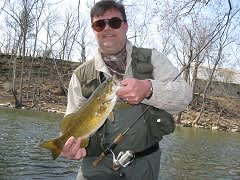New Fishing Regulations for Kentucky in 2013

Next week, the Kentucky Afield Outdoors staff begins a series of fishing articles called “Spring Fishing Frenzy” that will run until early summer. The series of articles details the excellent fishing opportunities across Kentucky.
Before the series begins Feb. 7, anglers should know of new fishing regulations that go into effect March 1, 2013. These new regulations include changes to smallmouth bass regulations in Otter Creek Park Outdoor Recreation Area, a reduction of the striped bass minimum size limit in Lake Cumberland, some new catfish regulations at three state-owned lakes and modification of snagging regulations statewide.
Meade County’s Otter Creek Park closed for two years prior to its acquisition as Otter Creek Park Outdoor Recreation Area by the Kentucky Department of Fish and Wildlife Resources. The park opened again to public use in 2011.
The smallmouth bass living in Otter Creek didn’t see any anglers during those two years and also grew a little.
“When Otter Creek opened back up for public access, the smallmouth bass harvest pressure increased dramatically,” said Gerry Buynak, assistant director for fisheries for the Kentucky Department of Fish and Wildlife Resources. “To protect those bigger smallmouths, we implemented a slot limit similar to the one on Elkhorn Creek in central Kentucky.”
Anglers fishing Otter Creek must immediately release all smallmouth bass caught between 12 and 16 inches. The daily creel limit is 6 smallmouth bass, but only one may be longer than 16 inches.
“The slot limit on Elkhorn Creek has been extremely successful in protecting the quality-sized, larger smallmouth bass,” Buynak said. “There are more smallmouth bass over 16 inches in the creek than ever before.”
The Lake Cumberland drawdown that began in 2007 to facilitate repairs on Wolf Creek Dam stressed the fantastic striped bass fishery in the lake. The loss of 40 feet of water from the lake during the drawdown phase took much of the cold, oxygenated water striped bass need to survive, especially during the summer months. Thousands died in late summer and early fall for a couple of years because of the lack of deep, cool oxygenated water.
Then, some good survival years of the stocked striped bass produced a fishery made up of fish just under the minimum size limit of 24 inches. “The stripers from 20 to 22 inches piled up,” Buynak explained. “The growth rate and condition of the fish deteriorated.”
Therefore, last May, the new 22-inch minimum size limit on striped bass went into effect. This regulation change will continue in 2013.
“We want people to harvest some of these fish,” Buynak said. “Thinning them out helps the growth and condition of the fish. When the lake returns to full pool in 2014, a decision will have to be made about keeping the 22-inch size limit or returning it to 24 inches.”
The two fish daily creel limit on striped bass in Lake Cumberland remains in effect.
Beginning March 1, 2013, there will be a 12-inch minimum size limit for channel and blue catfish on McNeely Lake in Jefferson County, Reformatory Lake in Oldham County and Lake Reba in Madison County.
“The new 12-inch minimum size limit on catfish is part of a research study,” Buynak said. “We really didn’t know about the catfish population in some of the smaller state-owned lakes before we put a 12-inch minimum size limit for catfish on them. These three lakes had no size limit and an unlimited daily creel limit, so we are going to closely monitor the catfish in these lakes after this 12-inch size limit.”
Buynak said the data gleaned from the project will help make better management decisions on catfish regulations on state-owned lakes in the future.
The Kentucky Fish and Wildlife Commission removed the 7 ½ -foot rod length limit for snagging beginning Mar. 1. They also added James D. Beville Park Lake in Grayson County and Jacobson Park Lake in Fayette County to the Fishing in Neighborhoods (FINs) program.
Remember to keep these new regulations in mind when you fish in 2013 and look for the Kentucky Afield Outdoors “Spring Fishing Frenzy” series beginning next Thursday.
Also, don’t forget to purchase your new fishing license soon, as they expire Feb. 28.
Author Lee McClellan is an award-winning associate editor for Kentucky Afield magazine, the official publication of the Kentucky Department of Fish and Wildlife Resources. He is a life-long hunter and angler, with a passion for smallmouth bass fishing.

